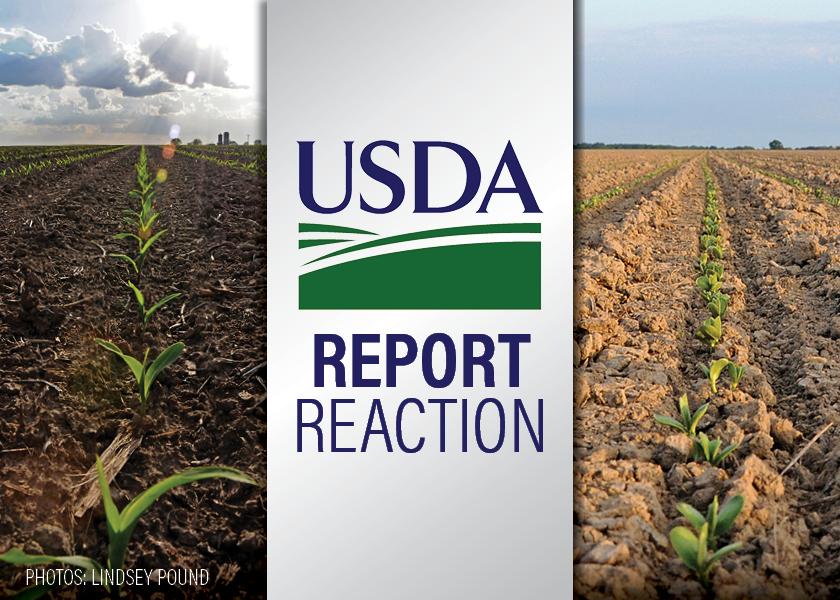PF Report Reaction: USDA unexpectedly keeps corn, soybean ending stocks unchanged

Market reaction
Ahead of USDA’s reports, corn futures were trading narrowly mixed, soybeans were 7 to 11 cents higher, winter wheat futures were 4 to 8 cents lower, spring wheat was narrowly mixed and cotton was 10 to 20 points lower.
As of 11:20 a.m. CT, corn futures are trading 3 to 4 cents lower, soybeans are 6 to 9 cents higher, winter wheat futures are mostly 1 to 3 cents lower, spring wheat is 6 to 9 cents lower and cotton futures are 20 to 40 points lower.
U.S. carryover
Corn: 1.342 billion bu. for 2022-23; unchanged from 1.342 billion bu. in March
Beans: 210 million bu. for 2022-23; unchanged from 210 million bu. in March
Wheat: 598 million bu. for 2022-23; up from 568 million bu. in March
Cotton: 4.1 million bales for 2022-23; down from 4.3 million bales in March
USDA left the corn carryover projection for 2022-23 unchanged from last month. That means projected carryover is 23 million bu. above the average pre-report trade estimate. Lower carryover expectations were driven by USDA’s March 1 Quarterly Grains Stocks Report that had corn stocks in all positions below trade expectations. USDA cut total supply 10 million bu. by dropping estimated imports to 40 million bushels. Totals use was also down 10 million bu. by way of a 10-millon-bu. cut to estimated food, seed & industrial (FSI) use to 6.68 billion bushels. (Corn-for-ethanol use is included in the FSI total but was unchanged from last month at 5.25 billion bushels.) USDA puts the national average on-farm cash corn price at $6.60, unchanged from last month but up 60 cents from last year.
Soybean carryover is unchanged from last month and 12 million bu. above the average pre-report trade estimate. As with corn, expectations for a cut to bean carryover were driven by the lower-than-expected March 1 soybean stocks. Surprisingly, USDA made no changes to the supply- or demand-side of the old-crop balance sheet. USDA puts the national average on-farm cash soybean price at $14.30, unchanged from last month but $1.00 above last year.
Wheat carryover is up 30 million bu. from last month and is 24 million bu. above the average pre-report trade estimate. USDA increased estimated wheat imports 5 million bu. (to 125 million) to push total supplies up by that amount. USDA left estimated food use unchanged at 975 million bu. and kept its export forecast at 775 million bu. but cut feed & residual use 25 million bu. to just 55 million bushels. USDA puts the national average on-farm cash corn price at $8.90, down a dime from last month but still up $1.27 from last year.
USDA cut 200,000 bales from its 2022-23 cotton carryover forecast. That puts cotton carryover 200,000 bales below the average pre-report trade estimate. USDA made no change to the supply-side of the balance sheet and increased projected exports 200,000 bales (to 12.2 million bales). While the export forecast is up from last month, it is still 2.42 million bales below last year’s cotton export tally. USDA puts the national average on-farm cash cotton price at 82 cents, down a penny from last month and 9.4 cents below year-ago.
Global carryover
Corn: 295.35 MMT for 2022-23; down from 296.46 MMT in March
— compares with 306.91 MMT in 2021-22
Beans: 100.29 MMT for 2022-23; up from 100.01 MMT in March
— compares with 99.73 MMT in 2021-22
Wheat: 265.05 MMT for 2022-23; down from 267.20 MMT in March
— compares with 272.09 MMT in 2021-22
Cotton: 92.01 million bales for 2022-23; up from 91.15 million bales in March
— compares with 86.23 million bales in 2021-22
Global production highlights
Argentina beans: 27.0 MMT for 2022-23; compares with 33.0 MMT in March
— compares with 43.9 MMT in 2021-22
Brazil beans: 154.0 MMT for 2022-23; compares with 153.0 MMT in March
— compares with 130.5 MMT in 2021-22
Argentina wheat: 12.55 MMT for 2022-23; compares with 12.9 MMT in March
— compares with 22.15 MMT in 2021-22
Australia wheat: 39.0 MMT for 2022-23; compares with 39.0 MMT in March
— compares with 36.24 MMT in 2021-22
China wheat: 137.72 MMT for 2022-23; compares with 137.72 MMT in March
— compares with 136.95 MMT in 2021-22
Canada wheat: 33.82 MMT for 2022-23; compares with 33.82 MMT in March
— compares with 22.42 MMT in 2021-22
EU wheat: 134.34 MMT for 2022-23; compares with 134.70 MMT in March
— compares with 138.24 MMT in 2021-22
Russia wheat: 92.0 MMT for 2022-23; compares with 92.0 MMT in March
— compares with 75.16 MMT in 2021-22
Ukraine wheat: 21.0 MMT for 2022-23; compares with 21.0 MMT in March
— compares with 33.01 MMT in 2021-22
China corn: 277.2 MMT for 2022-23; compares with 277.2 MMT in March
— compares with 272.55 MMT in 2021-22
Argentina corn: 37.0 MMT for 2022-23; compares with 40.0 MMT in March
— compares with 49.5 MMT in 2021-22
Brazil corn: 125.0 MMT for 2022-23; compares with 125.0 MMT in March
— compares with 116.0 MMT in 2021-22
Ukraine corn: 27.0 MMT for 2022-23; compares with 27.0 MMT in March
— compares with 42.13 MMT in 2021-22
South Africa corn: 16.7 MMT for 2022-23; compares with 16.7 MMT in March
— compares with 16.14 MMT in 2021-22
China cotton: 30.5 million bales for 2022-23; compares with 29.5 million bales in March
— compares with 26.8 million bales in 2021-22






